|
Campaign of the Carolinas [February-April 1865]
| Civil War North Carolina Campaigns Map |

|
| Carolinas Campaign, aka Campaign of the Carolinas |
Campaign of the Carolinas, aka Carolinas Campaign, was the final
campaign that consisted of a series of battles in the Western Theater* of the American Civil War. In January 1865,
Union Maj. Gen. William Tecumseh Sherman advanced north from Savannah, Georgia, through the Carolinas, with the intention
of linking up with Union forces in Virginia (see Sherman's March to the Sea and Campaign of the Carolinas History). The defeat of Confederate Gen. Joseph E. Johnston's army at the Battle
of Bentonville in March, and its surrender in April, represented the loss of the final major army of the Confederacy. The
Carolinas Campaign was also the final thrust in Sherman's March to the Sea.
*Although the campaign took place entirely in states on the Eastern Seaboard
of the United States, it is considered part of the Western Theater because it was a continuation of an offensive by the western
armies under Sherman (the Military Division of the Mississippi), starting in Tennessee the previous year.
| Campaign of the Carolinas Map |
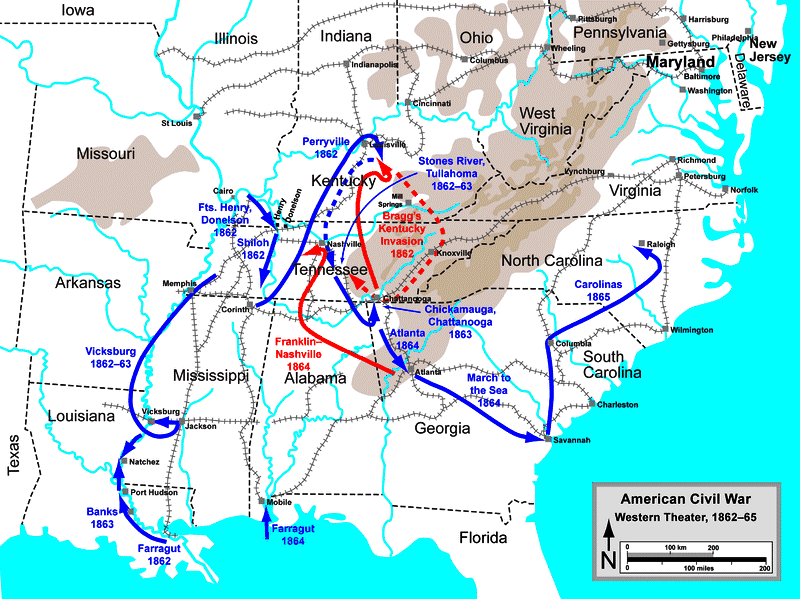
|
| (Western Theater of the American Civil War Map) |
"The Carolinas Campaign, aka Campaign of the Carolinas, consisted
of the following battles: Battle of Rivers' Bridge , Battle of Wyse Fork (aka Second Kinston), Battle of Monroe's Crossroads (aka Fayetteville Road, Blue’s Farm), Battle of Averasborough (aka Averasboro, Taylor’s Hole Creek, Smithville, Smiths Ferry, Black
River), and Battle of Bentonville."
| Carolina Campaign Map |
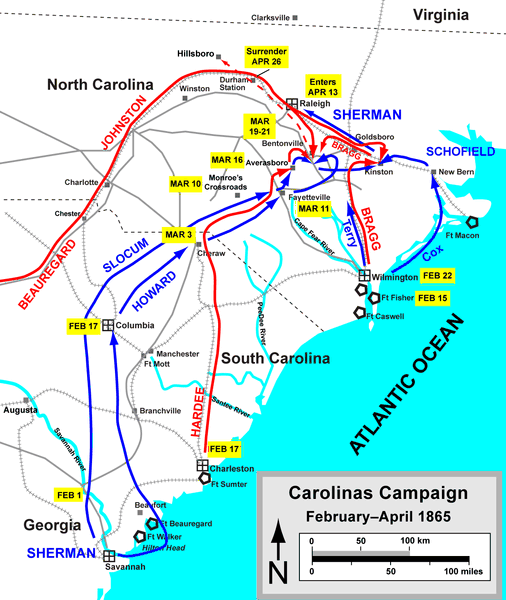
|
| Gen. Sherman's March Through the Carolinas |
| Sherman's March to the Sea |
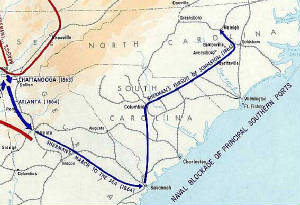
|
| (Carolina Campaign Map) |
After Sherman captured Savannah, the culmination of his march to the sea, he was ordered by Union Army general-in-chief
Lt. Gen. Ulysses S. Grant to embark his army on ships to reinforce the Army of the Potomac
and the Army of the James in Virginia, where Grant was bogged down in the Siege of Petersburg against Confederate General Robert E. Lee. Sherman, however, had a grander
plan in mind. He predicted on January 5, 1865:
"I do think that in the several grand epochs of this war, my name will
have a prominent part."
He persuaded Grant that he should
march north through the Carolinas instead, destroying everything of military value along the way, similar to his march to
the sea through Georgia. Sherman was particularly interested in targeting South Carolina, the first state to secede from the Union, for the effect it would have
on Southern morale.
| General Sherman's thrust to Bentonville |
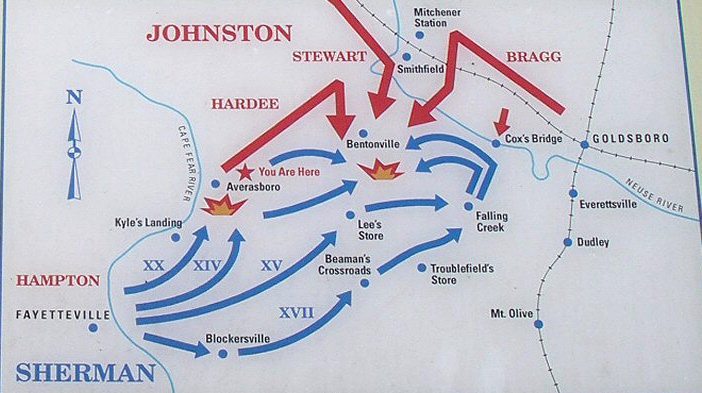
|
| (Battle of Bentonville Map) |
| General William T. Sherman |
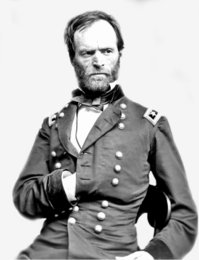
|
| (LOC) |
Sherman's army commenced toward Columbia, South Carolina, in late January
1865. His 60,079 men were divided into three wings: the Army of the Tennessee, under Maj. Gen. Oliver O. Howard, the Army
of the Ohio under Maj. Gen. John M. Schofield, and two corps, the XIV and XX, under Maj. Gen. Henry W. Slocum, which was later
formally designated the Army of Georgia. Reinforcements arrived regularly during his march north, and, by April 1, he commanded
88,948 men.
The Confederate army, moreover, was considerably smaller. The
primary force in the Carolinas was the battered Army of Tennessee, again under the command of General Joseph E. Johnston (who
had been relieved of duty by Confederate President Jefferson Davis during the Atlanta Campaign against Sherman). His strength
was recorded in mid-March at 9,513 and 15,188 by mid-April. The army was organized into three corps, commanded by Lt. Gen.
William J. Hardee, Lt. Gen. Alexander P. Stewart, and Lt. Gen. Stephen D. Lee. Also in the Carolinas were cavalry forces from
the division of Maj. Gen. Wade Hampton and a small number in Wilmington under Gen. Braxton Bragg.
| The Sherman March, North & South Carolina Campaign |
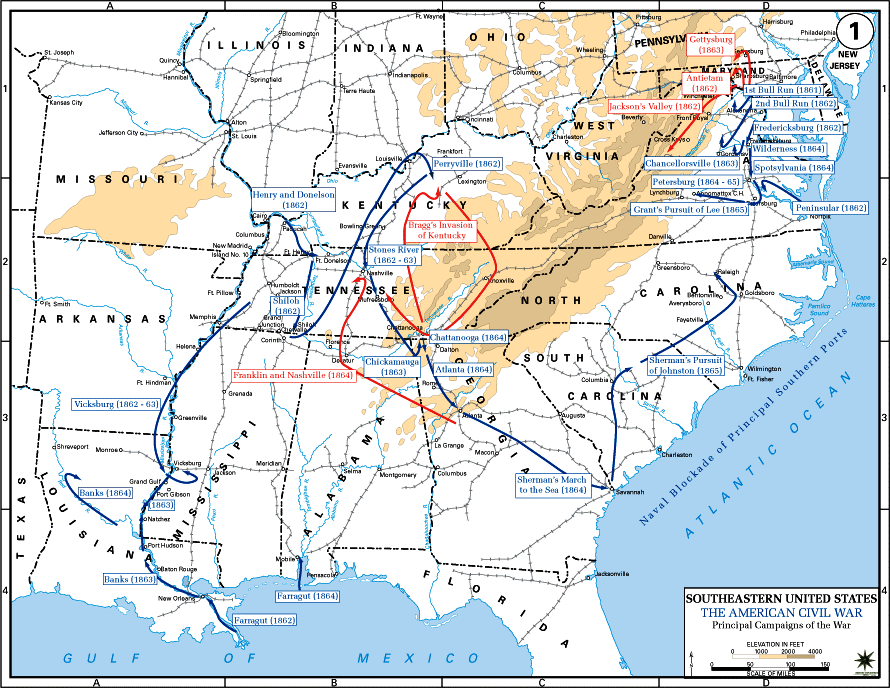
|
| (Major Civil War Turning Points Battles & Campaigns Map) |
| General Joseph E. Johnston |
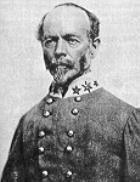
|
| (LOC) |
Sherman's plan was to bypass the minor Confederate troop concentrations
at Augusta, Georgia, and Charleston, South Carolina, and reach Goldsboro, North Carolina, by March 15. As with his Georgia
operations, Sherman marched his armies in multiple directions simultaneously, confusing the scattered Confederate defenders
as to his first true objective, which was the state capital of Columbia.
Sherman's Carolina Campaign, in which his troops marched 425 miles in 50
days, had been similar to his march to the sea through Georgia (see also Georgia Civil War History), although physically more demanding. However, the Confederate forces opposing him were much smaller and more
dispirited. When Joseph E. Johnston met with Jefferson Davis in Greensboro in mid-April, he told the Confederate president:
"Our people are tired of the war, feel themselves whipped, and will not
fight. Our country is overrun, its military resources greatly diminished, while the enemy's military power and resources were
never greater and may be increased to any extent desired. ... My small force is melting away like snow before the sun."
| Carolinas Campaign |
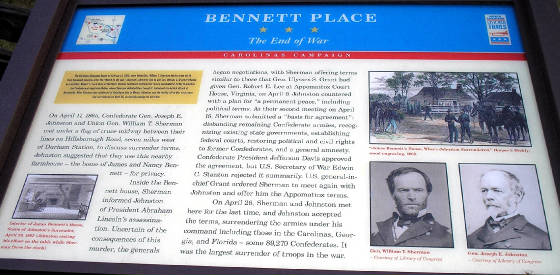
|
| Campaign of the Carolinas History |
| South Carolina Civil War Map of Battles |
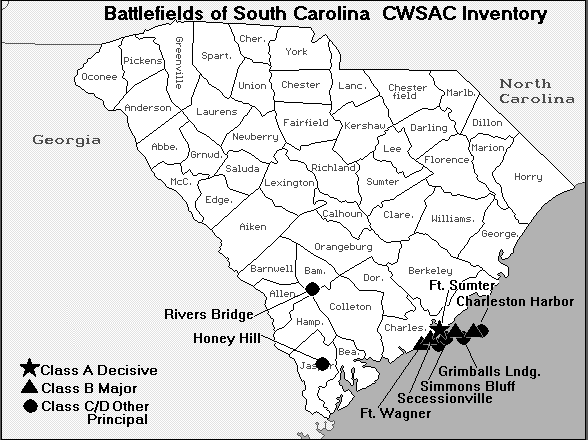
|
| Campaign of the Carolinas |
On April 18, three days after the death of President Abraham Lincoln, Johnston
signed an armistice with Sherman at Bennett Place, a farmhouse near Durham Station. Sherman got himself into political hot
water by offering terms of surrender to Johnston that encompassed political issues as well as military, without authorization
from General Grant or the United States government.
The confusion on this issue lasted until April 26, when Johnston agreed
to purely military terms and formally surrendered his army and all Confederate forces in the Carolinas, Georgia, and Florida.
It was the second significant surrender that month; on April 9, Robert E. Lee had surrendered the Army of Northern Virginia
at Appomattox Court House. It was the virtual end for the Confederacy, although some smaller forces held out, or resisted,
particularly in the Trans-Mississippi region, into the summer. See also South Carolina Civil War History.
(References and related reading below.)
Recommended Viewing: The
History Channel Presents Sherman's March (2007). Description: “The story of General William Tecumseh Sherman who helped devastate the South's army at the end
of the Civil War is told here via vivid reconstructions of his actions.” This is a great reenactment, presentation.
It's not dull like some documentaries that just continually talk with the same guy for an hour. This includes several individuals
that are extremely knowledgeable in their respective fields--be it civilian or military historian. Continued below...
Also, it includes many re-enactors that portray “Sherman as well as his entire command.” It literally
takes the viewer back to 1864 to experience it firsthand. The viewer will also hear from acclaimed authors and renowned historians
as they address some of the most controversial questions, including: "Who burned Atlanta?" "Was the burning of Atlanta ordered
by Gen. Sherman?" "Were innocent civilians killed by Union soldiers and were homes and building needlessly destroyed?"
Carolinas Campaign, aka Campaign of the Carolinas [February-March
1865]
Recommended Reading: Sherman's March:
The First Full-Length Narrative of General William T. Sherman's Devastating March through Georgia
and the Carolinas. Description: Sherman's March is the vivid narrative of General
William T. Sherman's devastating sweep through Georgia and the Carolinas in the closing days of the Civil War. Weaving together hundreds of eyewitness stories, Burke
Davis graphically brings to life the dramatic experiences of the 65,000 Federal troops who plundered their way through the
South and those of the anguished -- and often defiant -- Confederate women and men who sought to protect themselves
and their family treasures, usually in vain. Dominating these events is the general himself -- "Uncle Billy" to his troops,
the devil incarnate to the Southerners he encountered.
Recommended
Reading: Sherman's March Through the Carolinas. Description: In retrospect, General William Tecumseh Sherman considered his march
through the Carolinas the greatest of his military feats, greater even than the Georgia
campaign. When he set out northward from Savannah with 60,000
veteran soldiers in January 1865, he was more convinced than ever that the bold application of his ideas of total war could
speedily end the conflict. Continued below…
John Barrett's
story of what happened in the three months that followed is based on printed memoirs and documentary records of those who
fought and of the civilians who lived in the path of Sherman's onslaught. The burning of Columbia, the battle
of Bentonville, and Joseph E. Johnston's surrender nine days after Appomattox are at the center of the story, but Barrett
also focuses on other aspects of the campaign, such as the undisciplined pillaging of the 'bummers,' and on its effects on
local populations. About the Author: John G. Barrett is professor emeritus of history at the Virginia Military Institute.
He is author of several books, including The Civil War in North Carolina,
and coeditor of North Carolina Civil War Documentary.
Recommended
Reading: On Sherman's Trail: The Civil War's North
Carolina Climax.
Description: Join journalist and historian Jim Wise as he follows Sherman's last march through
the Tar Heel State from Wilson's Store to the surrender at
Bennett Place. Retrace the steps of the soldiers at
Averasboro and Bentonville. Learn about what the civilians faced as the Northern army approached and view the modern landscape
through their eyes. Whether you are on the road or in a comfortable armchair, you will enjoy this memorable, well-researched
account of General Sherman's North Carolina campaign and
the brave men and women who stood in his path.
Recommended
Reading: Southern Storm: Sherman's March to the Sea, by Noah Andre Trudeau (Hardcover). From Publishers Weekly: Starred
Review. Trudeau, a prize-winning Civil War historian (Gettysburg),
addresses William T. Sherman's march to the sea in the autumn of 1864. Sherman's
inclusion of civilian and commercial property on the list of military objectives was not a harbinger of total war, says Trudeau.
Rather, its purpose was to demonstrate to the Confederacy that there was no place in the South safe from Union troops. Continued
below…
The actual levels of destruction
and pillage were limited even by Civil War standards, Trudeau says; they only seemed shocking to Georgians previously spared
a home invasion on a grand scale. Confederate resistance was limited as well. Trudeau praises Sherman's
generalship, always better at operational than tactical levels. He presents the inner dynamics of one of the finest armies
the U.S. has ever fielded: veteran troops from Massachusetts
to Minnesota, under proven officers, consistently able to
make the difficult seem routine. And Trudeau acknowledges the often-overlooked contributions of the slaves who provided their
liberators invaluable information and labor. The march to the sea was in many ways the day of jubilo, and in Trudeau it has
found its Xenophon. 16 pages of b&w photos, 36 maps.
Recommended
Reading: The March to the Sea and Beyond: Sherman's Troops in the
Savannah and Carolinas
Campaigns. Description: This book contains
an examination of the army that General William Tecumseh Sherman commanded through Georgia and the Carolinas, in late 1864
and early 1865. Instead of being just another narrative of the March to the Sea and Carolina Campaigns, however, Glatthaar's
book is a look at the individuals that composed the army. He examines the social and ideological backgrounds of the men in
Sherman's army, and
evaluates how they felt about various factors of the war--slavery, the union, and, most significantly, the campaign in which
they were participating. Continued below…
The result
is a fascinating look at Sherman's
campaigns through the eyes of the everyday soldier. Glatthaar makes the army come alive, and shows the men not as heartless
animals who delighted in wanton destruction, not as mechanized marching machines who could perform the most difficult marches
without even flinching, but instead as real human beings, complete with sore feet, empty stomachs, and minds engaged in contemplation
over the ethical ramifications of what they were doing to the people of the South. This book is a refreshing change from the
norm in Civil War history. The book’s great value is its ability to assist the reader in understanding that the war
was fought by individuals--not masses of blue and gray--and what these individuals felt, thought, and believed during America’s
most trying era.
Recommended Reading: The
Battle Of Bentonville: Last Stand In The Carolinas (Hardcover: 575 pages). Description: As Sherman completed the destruction of Georgia,
only the outnumbered but wily Confederate commander Joseph E. Johnston stood between Sherman’s
army and the conquest of North and South Carolina. Finally,
the Battle of Bentonville and the Campaign of the Carolinas ‘gets its
well deserved attention.’ Bradley takes the reader from the last organized skirmish against Sherman's
army in South Carolina to the climatic Battle
at Bentonville. In between, Bradley discusses in detail the Campaign of the Carolinas, which includes the following battles:
Rivers’ Bridge, Wyse Fork (aka 2nd Kinston), Monroe’s
Crossroads, Averasborough (aka Averasboro), and the grand finale at Bentonville. On these pages, you will literally feel like
you are emotionally rising and falling with Johnny Reb and Billy Yank. You will feel that Rebel Yell screaming in your ears
and imagine that crackle of musketry. Continued below…
But
the finest aspect of the book is its gripping depiction of the Battle of Bentonville; it was literally the Confederate’s
last stand to halt Major General William T. Sherman's march through the Carolinas. For nearly a day, a rag tag, mottled army of Confederates from every corner
of the Confederacy had the previously unchallenged army of Sherman
"on the ropes." However, as the book vividly describes, the determination of a few Federal divisions and reinforcements save
the Union army. In between the vivid descriptions of the fighting, Bradley masterfully throws in personal recollections and
eyewitness accounts that are unmatched by previous books on the Campaign. An outstanding ‘photo section’ reflects
the battlefield from numerous viewpoints, as well as several good-sized photographs of the participants. Also, and most importantly,
the book is devoid of prejudice and bias. You will be hard pressed to find a more objective study; even for a subject that
pulls so much emotion as Sherman's march. If you read
just one book on the rarely discussed Campaign of the Carolinas, with the Battle of Bentonville,
and the Confederacy’s last stand... READ THIS ONE. You will not be disappointed.
References: Eicher, David J., The Longest Night: A Military History of the
Civil War, Simon & Schuster, 2001; North Carolina Office of Archives and History; Official Records of the Union and Confederate
Armies.
|

